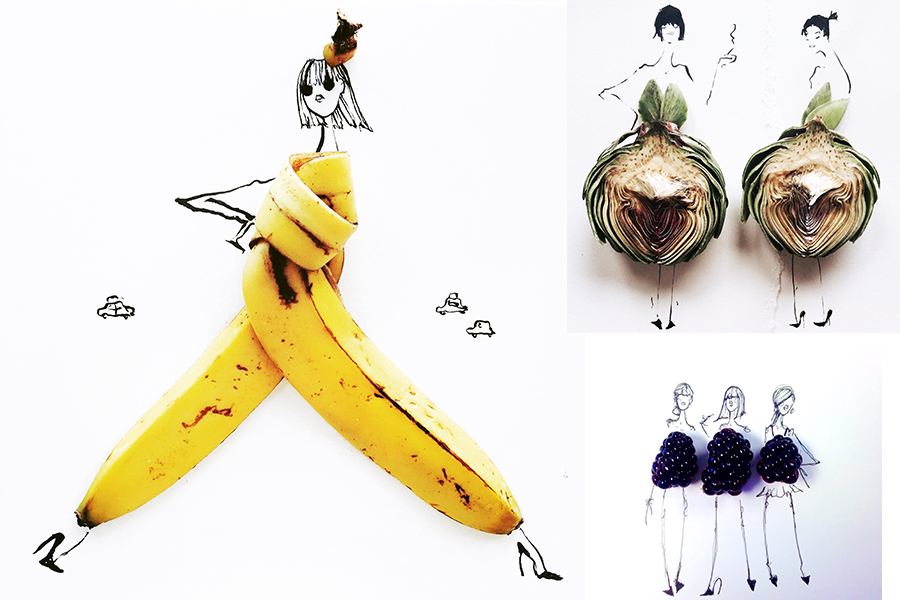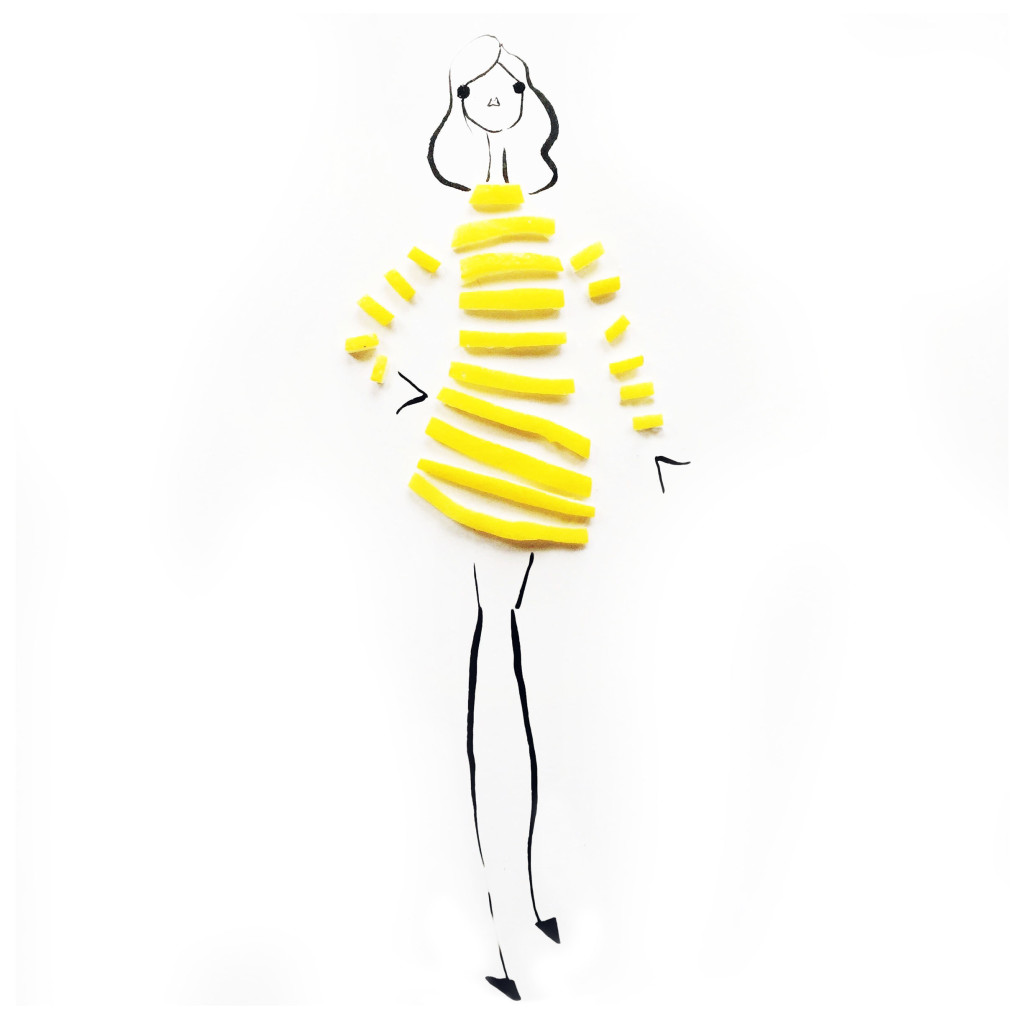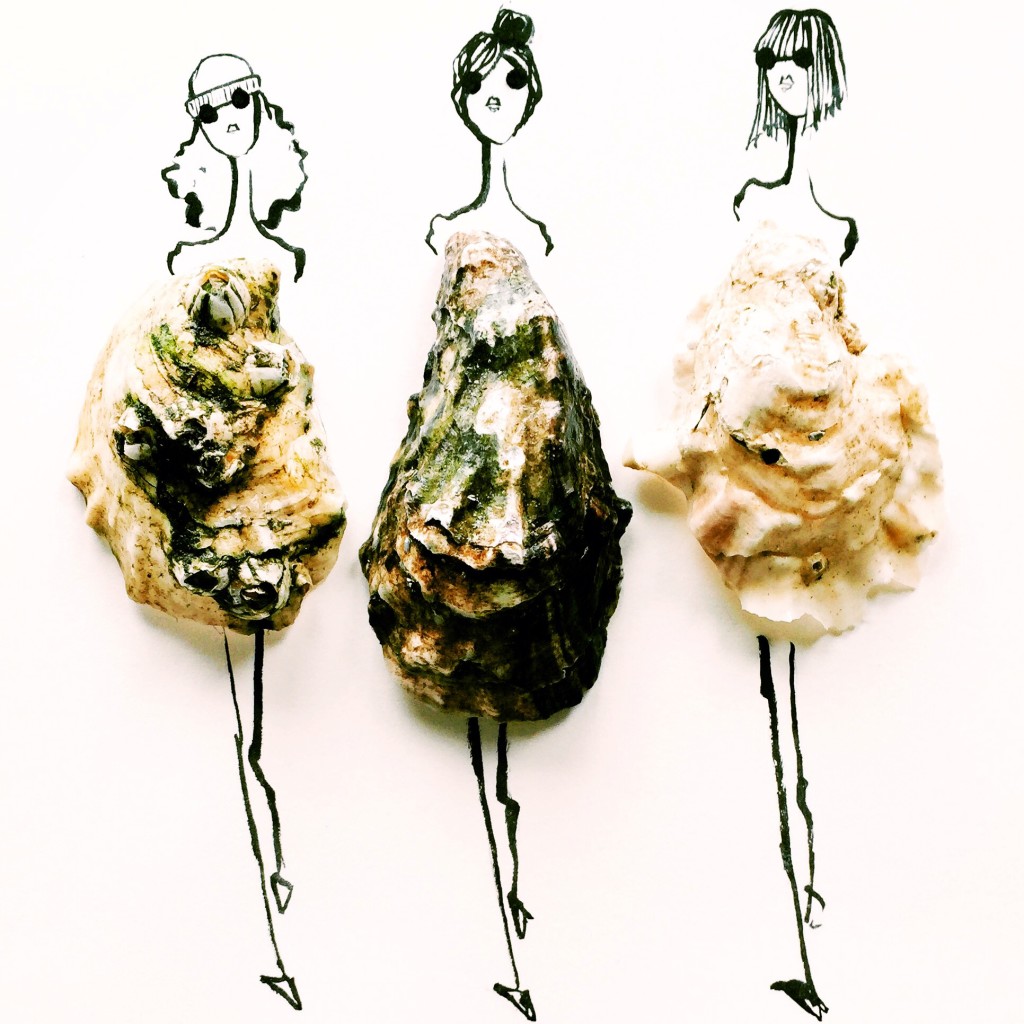How the Midwestern transplant found Instagram inspiration from California produce.
by Paige Pritchard
images courtesy of Gretchen Roehrs
Banana peels and oyster shells are two of the many mediums fashion illustrator Gretchen Roehrs has found herself working with as of late. The evidence can be found on her Instagram account, where she’s been posting her delightful drawings with increasing regularity since March. Recent coverage from blogs at Refinery29, Vogue Brasil and Harpers Bazaar has resulted in a significant bump in followers, which serves as encouragement for Roehrs to continue her art. Her source material frequently changes – peas and peppers make an appearance alongside the rare egg yolk – but all come affixed with a sassy sketch. This combination of food and figure drawing started as a joke for a friend this past spring, but has since grown into a fun exercise in expression for Roehrs.
Roehrs moved from Missouri to San Francisco three years ago, and has since built up her tech prowess working at area startups like Shopkick. She now uses her aesthetic eye on a daily basis as the lead UX (user experience) designer for Chime. Outside of work she still fervently pursues her interests in fashion design, as proved by her illustrations and deep knowledge of the industry. Disclosure: I’ve known Roehrs since her college years in Missouri, so when I saw her Instagram gaining attention I knew there was a lot more going on behind those sketches than some stylish ink and fruit. Thankfully, I had the opportunity to pick her brain about blurring the lines between fashion and food, and how the two are more similar than expected.
Paige Pritchard: What is your background in fashion illustration and how do you use that art on a day-to-day basis?
Gretchen Roehrs: I went to school for fashion design and product development at Stephens College [in Columbia, MO], and a big part of that was learning how to understand the human figure. We started with some very intense live drawing [lessons] where we would draw nude models, and I always loved it.
When we “graduated” from that we were able to take on more fashion figures, which is kind of a more exaggerated, elongated figure than the traditional human form. And I started playing with the proportions and exaggerating as much as I could. So, if I could make it kind of funny and a bit more like a cartoon and play with the proportions, it was always a little bit easier for me.
PP: How would you define fashion illustration? You mentioned that the figures are a little elongated and different. There seems to be a certain style to it. Why is that so?
GR: I think fashion is all fantasy. The traditional human figure is about eight heads tall, where the “head” is [measured from] your chin to the top of the head. But for the fashion figure we were always told to draw at least nine heads, with kind of a more leggy figure. It attaches some drama to it, and I think all fashion design is a little dramatic.
Fashion drawing has really taken off in the past couple of years; it’s kind of had a resurgence. Anyone can take a picture with their phone these days, but there’s something special about seeing how a human eye can transfer garments from what they see in front of them to a piece of paper. And it’s even better when they have some sort of – I hate to use the word “flare” – but some sort of extra creative sparkle on top.
PP: How did you start incorporating food with fashion illustrations?
GR: I started doing it as a little bit of a joke to a friend who is living on the east coast. He missed the produce in California, so I would always send him a picture of what I was eating for lunch and that kind of evolved into me making these funny little drawings around it. Because the produce out here is just something else, like fresh plums and peppers and tomatoes. It’s a form of art. Walking through a farmers market in California is just as good as walking through a gallery. It’s a feast for the eyes really; it’s gorgeous. So what’s funny about my illustrations is there’s very little that I do with it. Most of it is just this gorgeous produce standing out, and I just add a few squiggles here and there. My brain just goes haywire when I see all these colors and shapes and I can’t help but do something ridiculous with it.
PP: You’re definitely giving personality to produce. When you sit down and you see a piece of food, how do you decide what kind of illustration it’s going to be, or what kind of person the food will be?
GR: It sounds kind of crazy, but I feel like a lot of food is attached to a certain decade, or at least a silhouette. You can have something like a fig – it’s a little bit plumper and maybe has more of a 1960s miniskirt or mini dress feel to it.. Or you could do something with some fringe, like a fruit or a carrot that you could cut into ribbons and be more like a flapper dress.
My interest in cooking has really skyrocketed since moving out here [in 2012] since the ingredients are so incredible. And just seeing how you can use a knife to create anything you want – it’s like a little paintbrush, or not necessarily a paintbrush, more like how someone works with clay – you kind of chip away at it until it takes on the shape that you want to.
PP: And when you think about it, it’s also a great way to encourage a connection with food. I think that’s a huge part of the foodie movement right now. A lot of people feel that with mass-produced food there’s a disconnect to it, and that to get reconnected to food you have to plant or harvest it yourself. I like that you’re taking an alternative route of, “I’m going to draw sketches around it!”
GR: It’s a little unconventional. I think it’s also a nice way to share a tender moment with someone, something that’s relevant to them, something that’s going to make them laugh. That’s all I want to do, make people laugh. And my jokes aren’t very funny, so I just draw funny faces on little models.
PP: But you’re really good at the puns too! Like the “party ‘choke” or the “pealazzo pants”…
GR: Well, the “party ‘choke” was for this amazing editor I used to work for at Vogue, she has a book that just came out called “Always Pack A Party Dress” [by Amanda Brooks] and it’s all about her career and life. I thought of it and wondered, “What’s a funny food to tie in with this?” I thought, “Oh, always pack a party ‘choke” because I’d love to have this little party dress, love to wear it. And [Brooks] saw it and was just so delighted by it and got so tickled. I was like, “Man, this is the best feeling in the world!” – to make someone’s day by drawing something whimsical and funny. I guess if I keep doing it it’s because people keep laughing. Kind of like that person that keeps telling jokes at a party even when it’s not funny anymore. That’s me.
PP: What kinds of foods inspire you the most? Or what kind of foods do you think are the prettiest? Which ones are you attracted to draw or include in illustrations?
GR: Well, I love really beautiful and dramatic colors. But I’m also attracted to really wonky shapes. Actually, the first food drawing I did was this really misshapen tomato that I drew around and turned into a funny character. It was all about calling attention to this weird shape.
PP: Speaking of misshapen foods, I currently have your oysters pulled up…
GR: I love the oysters. What’s funny about the oyster dress is there’s this beautiful Alexander McQueen dress that looks like a pearled oyster shell. There’s one editorial, I forget which magazine it was in, but Natalia Vodianova modeled it, and she’s just standing on the beach and she looks like she washed up on shore. It’s the most glamorous thing I’ve ever seen, and [the dress] looks just like an oyster shell.
There’s just this fun crossover between fashion and food. One of my favorite garments of all time is this [Elsa] Schiaparelli dress, the famous lobster dress, that she did in collaboration with Salvador Dali. It’s so beautiful, and it just has a huge lobster on it. I think that’s going to be one of my next things, maybe go get a lobster and put it down and draw around it and make it into a dress.
PP: You mentioned earlier that you like to cook. What’s the process with these sketches? Are you in the middle of cooking something and inspiration hits, or are you just sitting there and grab a banana from the counter? When does the ideation occur?
GR: Sometimes when I get back from the market and I’m just so tickled like, “Oh man, I gotta cut this open now.” I sometimes get too excited, as you can see when I sliced my finger open when I got my Japanese mandoline. I started cutting [the] radish and just completely tore my finger apart. Sometimes I get home from the market and I start eating everything and I end up eating half my groceries in one sitting because they all look so beautiful. So sometimes that’s it and sometimes I’m cooking something and I’m prepping it and slicing it and there are days when my knife game is really strong and I’m cutting stuff very well and think, “What can I do with this?” And it evolves from there. And sometimes I see a funny picture and think “I could make that out of a banana.”
PP: Would you consider yourself a foodie and did you become one in California or were you one to begin with in Missouri?
GR: That’s a good question. I think a lot of people kind of bristle at the word “foodie,” but it’s kind of a fun community and it takes all kinds of cooks. You don’t have to have anything special to learn how to cook. I think that one of the neatest things about culture is just seeing how people feed each other on a daily basis. I really like the culture out here in California. We eat really fresh, delicious produce. It’s almost like its own creative prompt every week when you go to the market, like “Oh, here are some chilis you can work with this week; go create something.” It’s kind of like saying, “Here’s some fabric for this season, go work with it.” There are a lot of similarities.
PP: Are there any chefs that you really admire?
GR:. Anything René Redzepi does. And Christina Tosi at Momofuku Milk Bar; she is such a genius. She’s the one that created the birthday cake truffles and the compost cookies. I used to eat those every week in New York. That would be my treat to myself. I would go see a movie in the East Village and I’d get one of those cornflake cookies and compost cookies. That to me is such a New York experience. And of course Karli Kloss is getting into food now; she’s got her cookies with Christina at Milk Bar, and I think that’s so great. I make her Perfect 10 cookies all the time because they’re kind of like a healthy cookie that I can eat for breakfast.. And Chad Robertson from Tartine Bread; I also have such a crush on him. He has made the most perfect loaf of bread and I bow down to everything he does and his chef Elisabeth [Prueitt] – the creations at Tartine are just out of control. Those are some San Francisco people I’m in love with.
PP: What are some fashion designers you admire?
GR: When it comes to fashion I was always really inspired by the really classic designers, like Oscar De La Renta, Valentino, or even back to the early century designers like Paul Poiret and Madame Grès. Those are the people that really turned fashion. They took it from being something that was wearable to being an art; they really blurred the lines between a garment and art. I think that’s something that we don’t see as much anymore, but there are of course some people doing that. Like Hussein Chalayan, he’s this incredible designer, he’s best known for his coffee table dress, which is where he had a model walk up the runway, and there’s a coffee table there, and she steps inside of it and then raises it up around her and it kind of unfolds into this dress. That kind of creativity, that’s so rare to see. That’s what’s really exciting about fashion design. Who else? The Rodarte sisters, those are real gems. Those are two women pioneering for women just in the most beautiful way. Anything from Star Wars to Van Gogh paintings they’ve tackled and in ways I would have never thought I would have wanted to wear. Like all the sudden I’ll find myself wanting to go through a goth phase because of the Rodarte sisters, and that’s just a testament to their influence and their design.
[hr style=”striped”]
Paige Pritchard is a part time freelance journalist and a full time media junkie. Follow her on Twitter @peapodpritchard for commentary on movies, magazines, and current events.






